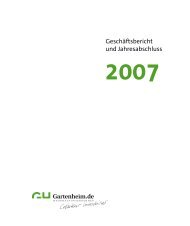analysis of the influences of solar radiation and façade glazing ...
analysis of the influences of solar radiation and façade glazing ...
analysis of the influences of solar radiation and façade glazing ...
Create successful ePaper yourself
Turn your PDF publications into a flip-book with our unique Google optimized e-Paper software.
4.1 Summary 100<br />
<strong>and</strong> determine <strong>the</strong> most important factors, especially <strong>solar</strong> <strong>radiation</strong>, affecting energy<br />
consumption was carried out.<br />
Special attention was focused on <strong>the</strong> heat transfer through windows. One <strong>of</strong> <strong>the</strong> main goals<br />
<strong>of</strong> <strong>the</strong> current work was <strong>the</strong> determination <strong>and</strong> comparison <strong>of</strong> <strong>the</strong> gain <strong>and</strong> loss <strong>of</strong> <strong>the</strong>rmal<br />
energy through <strong>the</strong> building fenestration. Glazed openings are very important elements in<br />
building design. Windows provide natural day-light into rooms to reduce <strong>the</strong> use <strong>of</strong> electric<br />
lights <strong>and</strong> allow heat gain from <strong>solar</strong> <strong>radiation</strong>. The type <strong>of</strong> <strong>glazing</strong> materials used in a<br />
building construction makes a significant contribution to <strong>the</strong> annual energy consumption.<br />
For this reason, it was decided to examine twelve cases <strong>of</strong> fenestration products with<br />
different types <strong>of</strong> low-e coatings <strong>and</strong> different configurations <strong>of</strong> optical filters on a glass<br />
surface. The parameters <strong>of</strong> <strong>the</strong> developed <strong>glazing</strong> systems such as visible transmittances,<br />
U-factor, <strong>solar</strong> heat gain <strong>and</strong> shading coefficients were determined with help <strong>of</strong> <strong>the</strong><br />
computer program WINDOW 5.2. The simulation results as indexes <strong>of</strong> building energy<br />
consumption, heating <strong>and</strong> cooling energy dem<strong>and</strong> were used to select <strong>the</strong> optimal window<br />
performance. Combinations <strong>of</strong> <strong>the</strong>rmal <strong>and</strong> optical properties <strong>of</strong> <strong>the</strong> recommended <strong>glazing</strong><br />
system should provide low energy consumption throughout <strong>the</strong> winter months due to <strong>the</strong><br />
highest passive <strong>solar</strong> transmission.<br />
Large areas <strong>of</strong> <strong>glazing</strong> in each facade <strong>of</strong> <strong>the</strong> developed buildings may result both in <strong>the</strong><br />
increase <strong>of</strong> heat losses in winter <strong>and</strong> <strong>the</strong> deterioration <strong>of</strong> <strong>the</strong>rmal comfort conditions for <strong>the</strong><br />
occupants by overheating during <strong>the</strong> summer. So, that is why <strong>the</strong> optimization procedure<br />
was presented <strong>and</strong> an optimal value <strong>of</strong> window-to-wall ratio that leads to a minimum<br />
energy consumption for space heating was determined.<br />
The current work reports energy balance <strong>of</strong> <strong>glazing</strong> system for north, south, west <strong>and</strong> east<br />
face <strong>of</strong> <strong>the</strong> developed building. Simulations were conducted for <strong>the</strong> following five<br />
locations in Germany: Hannover, Berlin, Düsseldorf, Frankfurt <strong>and</strong> Hamburg with<br />
different wea<strong>the</strong>r conditions.<br />
The variability <strong>of</strong> passive <strong>solar</strong> gains connected to <strong>the</strong> windows height above <strong>the</strong> ground<br />
level for heating <strong>and</strong> warm periods separately was <strong>the</strong> next problem resolved by <strong>the</strong> author.<br />
The research results concerning an <strong>analysis</strong> <strong>of</strong> <strong>the</strong> <strong>the</strong>rmal environment in <strong>the</strong> living<br />
apartments during <strong>the</strong> warm period were presented as well. The building indoor<br />
environment was described by using an operative temperature <strong>and</strong> a PMV index.<br />
A reduction <strong>of</strong> gains from <strong>solar</strong> <strong>radiation</strong> during <strong>the</strong> summer was performed by different<br />
combinations <strong>of</strong> protection shields made by movable glass parts printed with various<br />
patterns <strong>and</strong> internal alternatively external window shades with highly reflective<br />
parameters. In order to reduce <strong>the</strong> internal air temperature, we used intensive mechanical<br />
ventilation when <strong>the</strong> outdoor temperature was lower than <strong>the</strong> air temperature in rooms. The<br />
next series <strong>of</strong> calculations were performed to investigate how variable air volume system<br />
<strong>influences</strong> <strong>the</strong> <strong>the</strong>rmal environment in living spaces.





